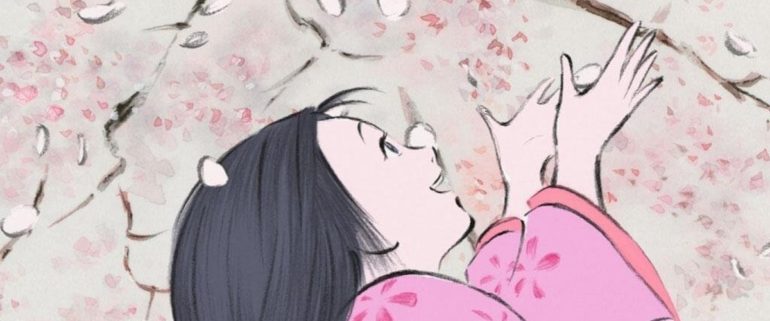It’s the big send off, the last hurrah, the final farewell and, most definitely, the end of an era. If reports are to be believed (and sadly it does appear so), The Tale of Princess of Kaguya is to set to be the ultimate cinematic output of Japanese animation powerhouse Studio Ghibli. Questions had long since surrounded the future of the studio when its master-helmer and co-founder, Hayao Miyazaki, announced his retirement from filmmaking last year. A number of months later, the cessation of film production now looks like all but a foregone conclusion. And so, it is with a tear, we salute the dream-engineers who delivered to our screens the likes of Spirited Away, Grave of the Fireflies, and My Neighbour Totoro, films immersed in the fantastical, often the bizarre, but crafted with an utterly human touch.”
And still, for all that suggests Princess Kaguya may signal the end, ironically there seems something incomplete about it. In contrast to Miyazaki’s vibrantly coloured frame and the precision of his pencil, the animation here appears unfinished. The sky is white instead of blue; characters and objects seem half-drawn, storyboarded almost, awaiting further layering to smooth out the apparent freneticism of it all. But for all its blank space and uncoloured facial portraits, not one element of Isao Takahata’s adroitly etched effort implies emptiness. On the contrary, Princess Kaguya may be one of Ghibli’s liveliest and most imaginative creations.
Of course, this is by no means a small statement to make, considering that this is the studio whose playful mind has previously concocted cat busses and walking domiciles. But, with Princess Kaguya, we get the unique sense of a film that starts from nothing and blossoms into something more vivid and powerful than we might have thought possible, one pencil stroke at a time. And in this vein, so too does its eponymous heroine arise from nowhere, simply shooting up from the ground at the beginning of her tale and presenting herself, palm-sized, to a bamboo farmer. The farmer takes her in as his own and rears her with his wife, marvelling at the breathtaking speed with which she grows. The local children nickname her ‘L’il Bamboo’, seeing her as one with nature. Her adoptive father, however, remains assured of her heavenly roots, and with a small treasure he finds in the stalk of a tree, he seeks for her the life of a noble princess, far away from this rural abode. T.S Eliot’s words ring true in that ‘Our beginnings never know our ends’.
Though Ghibli films are often heavily interlinked with Japanese myth, Princess Kaguya is dealing with a much more traditional form of fairy tale. But that is not to call it reserved or stoic. In actual fact, there’s an immediacy in Takahata’s style that is far removed from anything else the studio has produced. Japanese animation has long been revered for the inventive ways in which it captures movement, from the fast fleeting city streets of Akira to the looping trajectories of airplanes in the more recent The Wind Rises. Here, the beauty is to be found in the simpler actions like the sway of the trees in the wind. And yet, the film manages to encompass a sense of enormous vitality. It might be clichéd to argue that these animations ‘jump off the page’, but, at one stage, our heroine appears to do just that. Surrounded by suitors in her new found home, a regal palace that is more a prison to her than anything else, she yearns for the freedom of her previous life. Unable to withstand these feelings of entrapment, she bursts through the walls of the palace, racing across the moonlit night towards the promise of nature. In a spellbinding sequence, the animation descends into roughness as the princess moves through the darkness and the opaque shapes clouded by it, her hair a series of erratic leaden scribbles as opposed to a free-flowing mass. Engaging in the highest kind of stylistic innovation, it is as if the content has transcended the form.
But, the true brilliance of The Tale of Princess Kaguya lies in that it does what all great animation strives to do; it teaches us what it means to be human. It illustrates the intense power of empathy and the strength of the emotional ties we draw with those around us. And though animation is frequently suffused with notions magic and the spectacular, at its core are characters as intricate we are. The princess may spout from a hole in the ground, but by the end of the film, her existence is as true as ours. A fitting end, from the studio that urged us to become lost children together.

